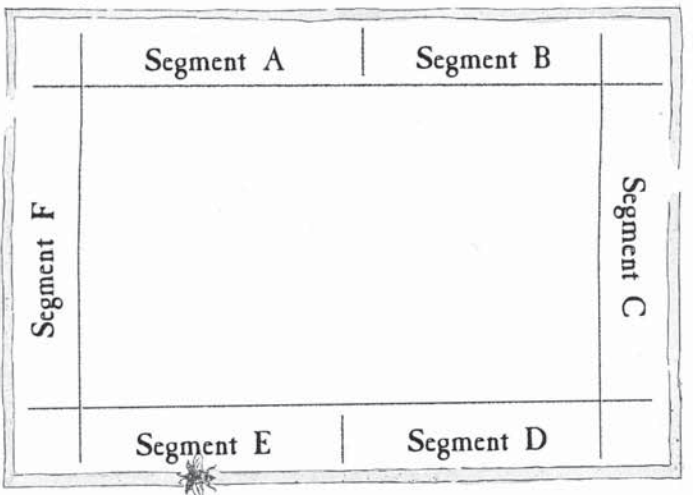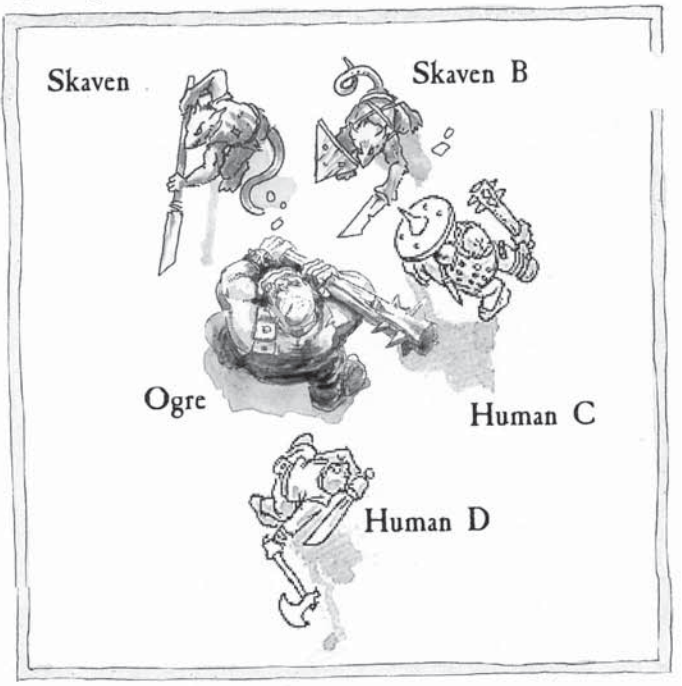Chaos on the Streets
Source: Town Cryer #5, Mordheim Annual 2002
Skirmishes between two warbands are a common occurrence but sometimes rival Mercenary Captains will lay their differences aside and ally against a common enemy. Mark Havener has written full rules for fighting larger games of Mordheim involving several players, as well as seven new scenarios.
These rules are designed for games of Mordheim that are not restricted to two players. Got an odd number of players one game night? Or just itching for an all-out titanic bash (perhaps the end of a league)? Try multiplayer Mordheim, and see what fun a truly chaotic game can be!
Rules for playing multiplayer games
Size of playing area
Multiplayer Mordheim obviously requires more room to play. While Mordheim normally plays fine in a 4'x4' area, the size of the playing area for multiplayer games should be at least 4'x6'. This is important for set-up as detailed below.
Attackers and defenders:
In scenarios where attackers and defenders are defined, the defender is the player whose warband has the highest rating. If more than one warband have the same highest rating, the defender will be the one among them whose warband includes the most models. If there is still a tie, roll a dice to determine who gets to be the defender.
There is only ever one defender, all the other warbands are the attackers.
Setting up the warbands
In scenarios where there is a defender, that player sets up his warband first. To determine who among the attacking warbands sets up next (or among all the warbands in a scenario without defined attackers and defenders), each player rolls a D6. The player with the highest roll sets up next and the remaining players set up in order of descending dice rolls.
Example: Phil, Bob, and Devin are playing Scenario 1, Treasure Hunt. This scenario has no attackers or defenders defined so all three roll a D6. Phil rolls a 3, Bob rolls a 5, and Devin rolls a 1. Bob must set up his warband first, then Phil, and finally Devin.
When it is his turn to set up his warband, each player must choose one segment of table edge (see the diagram below for what constitutes a 'segment') and set up his warband within 6" of it. No player may start a member of his warband within 6" of a member of another warband.
Diagram 1

Example: Continuing our example above. Bob places his warband first and chooses Segment D (bottom right corner). Phil sets up next and chooses Segment F (left side). Now Devin could choose any of the remaining edge segments, though he would probably be well advised to steer clear of Segment E as this places him right in the midst of his enemies (with a potentially constrained set-up area as well, if Bob and Phil placed any of their models close to that region!). Devin wisely chooses Segment B and sets his warband up there.
Note that some scenarios will have special set-up rules (usually for the defender) which are different from the above. Any such variation will be noted in the rules for that scenario.
Order of play
After all warbands have been set up, players must determine the order of play. Players should be arrayed about the table by their set-up segment (see above). Each player rolls a D6. The player with the highest roll gets the first turn. Play proceeds clock-wise around the table from there.
Example: Our three friends have their warbands set up on the table and are ready to determine who goes first. This time Devin rolls a 6, Bob rolls a 1 and Phil rolls a 2. Devin won the roll. so his warband will go first. Devin's models were set up in Segment B and the next warband clockwise is Bob's, so even though Bob got a lower dice roll than Phil, Bob's warband goes second and Phil's will go last.
Underdogs
In multiplayer Mordheim, the underdog is not so clear. Any warband can be an underdog if it is attacked by two or more of its rivals! Still, there may be cases where one warband is simply playing out of its league. To determine if a warband is an underdog in multiplayer Mordheim, simply take the warband with the lowest warband rating and compare it to the warband with the next highest rating. Use the difference in ratings and the chart from the Experience section of the Mordheim rules to determine if any experience bonus is justified for the lower warband, just as you would for the tower of two warbands in a two player game.
Example: Phil's Skaven has a warband rating of 176, Bob's Witch Hunters a rating of 195 and Devin's Mercenaries a racing of 123. Devin's warband has the lowest rating, so if there is an underdog, his warband will be it. To find out, we compare his rating to the next highest rating, 176 (Phil's Skaven). The difference is 53 (176 - 123 = 53), which according to our chart in the Mordheim rulebook warrants a + 1 experience bonus. If any of Devin's Mercenaries survive this fight, they'll have a good chance of gaining an Advance!
Shooting into close combat
Unlike in the regular Mordheim rules, it is possible to shoot into close combat in multiplayer games, just as long as the shooters belong to a different warband than the models involved in the Close Combat. Shooters must still fire at the closest enemy model as normal (unless they are in an elevated position, as per the normal rules). However, if the shooter hits a model involved in a close combat, the shot may well hit one of his opponents and not the model itself. Randomise any missile hits between the target and any models in close combat with him.
Close combat involving multiple warbands
In multiplayer Mordheim it is quite possible that one warband member gets charged by models from two or more opposing warbands. When this occurs, a model will fight during the Close Combat phase of each model it is fighting. This can give a model many attacks during a cycle of player turns but any model that has been ganged up on in this way is probably done for in any case!
Example: Bob's Ogre mercenary has been attacked by two of Devin's Humans and two of Phil's Skaven warriors. Phil's Skaven fight during his and Bob's close combat phases, Devin's Humans fight during his and Bob's close combat phases and Bob's Ogre attacks in each player's close combat phases. If one of Phil's Skaven (Skaven B) was in contact with one of Devin's Humans (Human C) (they are at the same corner of the Ogre's base, for example) and one of them decided to attack something a little easier, they could fight in each other's Close Combat phases as well. Note that a model that is attacking in another player's turn must attack one of that player's models. So in our example Phil's Skaven B could not use his extra attack during Devin's turn to attack Bob's Ogre - he must use it to attack Devin's Human C.
Diagram 2

Routing warbands
Unlike normal games of Mordheim, one warband failing its Rout test (or having all of its models taken out of action) does not necessarily end the game. Unless there are special victory conditions noted in the rules for the scenario you are using, a multiplayer game will last until there is only one warband left on the table. The player whose warband stays on the table for the longest is normally the winner, though in some scenarios the winner might be the warband leaving the table first, as it achieves its objective and leaves the scene!
Allies
Normal games of Mordheim involve one warband competing or fighting against another. Obviously, in this environment alliances are not normally possible. However, in multiplayer games, alliances are not only possible, they are a necessity for the completion of some scenarios! A single warband attempting to take out a dragon will find itself fighting an uphill battle with very little chance of success, indeed, it may well find itself lacking a few members after failing to complete its objective! Alliances can last until the end of the game (for example, two warbands can decide to ally against a third, and split whatever booty exists at the end), or they can be very temporary (often falling apart quite suddenly and violently!).
To form an alliance, a player must declare that he is doing so at the start of his turn. He must declare (to all players) which warband(s) he wants to ally with and if they agree, the alliance is formed. There is no limit to the number of warbands a player can ally with. The following special rules apply to a warband and its allies:
- Members of allied warbands do not count each other as enemies. Members of a warband may freely run within 8" of members of any warbands they are allied to. Models forced to charge enemy models due to some special rule (such as frenzy or Orc & Goblin Animosity) are not forced to charge allies. Note however that an Orc or Goblin failing an Animosity test counts allied models as friendly Hired Swords so if a '1' is rolled for the effects of the Animosity he will charge or shoot at them if they are the closest friendly models.
- Members of allied warbands that are in combat with one another when the alliance is announced will automatically break from combat. Place the models l" apart from each other. They can move as normal in their next Movement phase (so models knocked down or stunned follow the normal rules for being knocked down or stunned, etc).
- Initiating close combat with, shooting missile weapons at, or throwing non-helpful spells at a member of an allied warband automatically breaks the alliance with that warband. Note that this includes attacks caused by a failed Animosity rest. Your allies aren't going to be as forgiving of such behaviour as your own warband members might be!
Determining the scenario
To determine which scenario will be used for multiplayer games, players may either choose to play a particular scenario or roll on the following chart:
| 2D6 | Result |
|---|---|
| 2 | The player with the lowest warband rating may choose which scenario is played. |
| 3 | Play Scenario 7: Monster Hunt |
| 4 | Play Scenario 4: The Wizard's Mansion |
| 5-6 | Play Scenario 1: Treasure Hunt |
| 7 | Play Scenario 2: Street Brawl |
| 8-9 | Play Scenario 6: Ambush! |
| 10 | Play Scenario 5: The Pool |
| 11 | Play Scenario 3: The Lost Prince |
| 12 | The player with the lowest warband rating may choose which scenario is played. |
All currently transcibed multiplayer scenarios are listed with the Multiplayer tag.